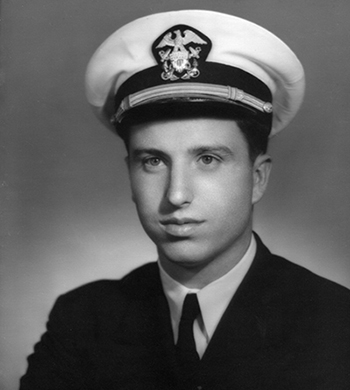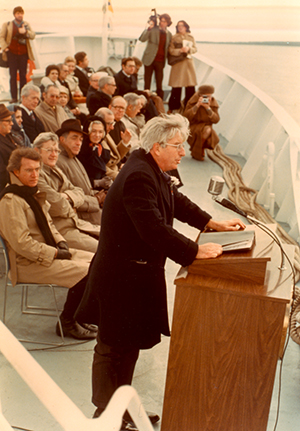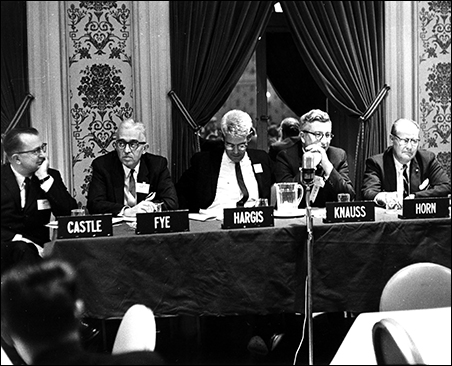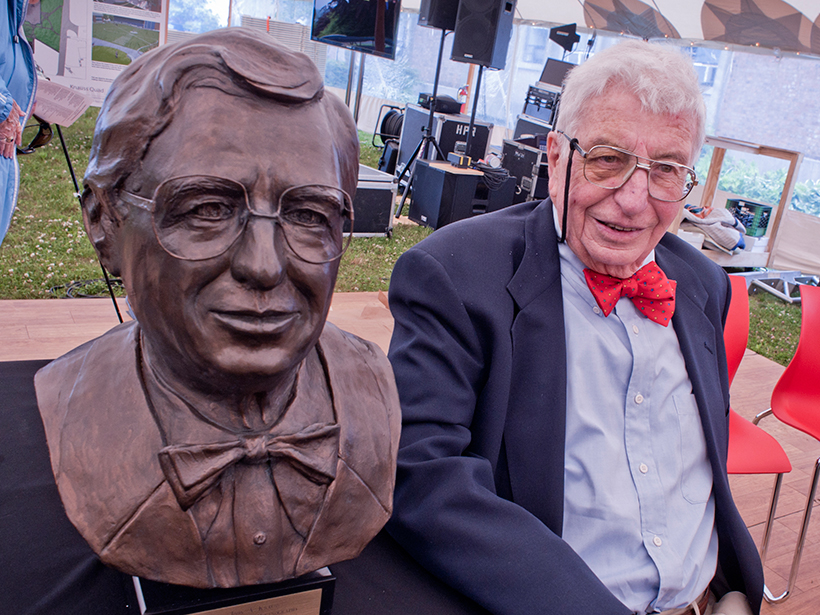
John A. Knauss, physical oceanographer of the equatorial oceans and founder of University of Rhode Island’s Graduate School of Oceanography (URI GSO), died on 19 November 2015 in Saunderstown, R.I. He was 90.
Knauss played a key role in the development of many of the iconic programs and institutions that are part of oceanography today. From heading the U.S. National Oceanic and Atmospheric Administration (NOAA, 1989–1993), to serving as the American Geophysical Union’s president (1998—2000), to helping found the National Sea Grant Program, to serving as a delegate to the United Nations Convention on the Law of the Sea (UNCLOS), Knauss fiercely supported oceanography and marine policy.
Early Life, Education, and Military Service
Knauss, born in Detroit, Mich., on 1 September 1925, was not initially trained as an oceanographer. He studied meteorology at the Massachusetts Institute of Technology through the U.S. Navy’s V-12 program, earning a B.S. in 1946.
As was common at the time, Knauss’s early work was intertwined with military service. He became an ensign in the U.S. Navy and served as a weather forecaster for the San Diego area, based out of Naval Air Station North Island.
After his service commitments ended, Knauss became a physicist with the Navy Electronics Laboratory in San Diego. He later studied physics at the University of Michigan, where he received his M.S. in 1949.
Work at ONR and Scripps
After earning his master’s degree, Knauss started working in Washington, D. C., in the recently founded Office of Naval Research (ONR). There, he helped disburse federal funds to oceanographers. He interacted regularly with Roger Revelle, who inspired Knauss to pursue oceanography as a career.
In 1962, the University of Rhode Island recruited Knauss to be the founding dean of its Graduate School of Oceanography.
Knauss left ONR for the Scripps Institution of Oceanography (SIO) to study with Revelle, who had, by 1950, returned to La Jolla to be the institution’s director. Knauss focused his research on the equatorial Pacific undercurrent, also known as the Cromwell Current, and was the first scientist to fully characterize it. He found that the undercurrent is a major component of the Pacific Ocean circulation. He also discovered a similar current in the Indian Ocean.
In 1959, after an interruption in his studies to once again work with the Navy at ONR, he received a Ph.D. in oceanography from SIO.

Founding GSO
In 1962, URI recruited Knauss to be the founding dean of GSO, a new oceanographic institution 6 miles away from the main campus, on Narragansett Bay.
Working with SIO, Knauss acquired a mothballed 180-foot, 1000-ton World War II Army vessel for $500 through the federal government’s educational surplus program. Renamed the R/V Trident, the vessel provided a research platform from which GSO faculty and students studied oceanography across the world for 15 years.
As dean, Knauss also oversaw the acquisition in 1977 of the R/V Endeavor, which is owned by the National Science Foundation. Endeavor will celebrate its 40th year as an active research vessel next year.
A Focus on Marine Affairs
Knauss served as URI’s provost for marine affairs (1969—1982) and vice president of marine programs (1982—1987). Throughout his career at URI, he never lost sight of the great potential of GSO to help foster marine programs at the main campus. Through his leadership, marine studies became an important university-wide theme.
Through Knauss’s leadership, marine studies became an important university-wide theme.
For example, Knauss helped found the Department of Geography and Marine Affairs at URI—the first marine affairs degree program in the country. He also helped establish the first ocean engineering department in the United States, as well as a resource economics department with a strong marine focus. He even helped to transform URI’s Animal Sciences Department into the Department of Fisheries, Animal, and Veterinary Sciences.
He retired from URI in 1990 and served in an emeritus capacity until his death.
Advancing National and Global Marine Initiatives
Knauss had a close relationship with Rhode Island’s senior senator, Claiborne Pell, who crafted legislation encouraged by Knauss and Athelstan Spilhaus to create the National Sea Grant Program. The National Sea Grant College Program and Act was passed in 1966. In recognition of Knauss’s leadership role in its development, the National Sea Grant Program established, in 1979, the John A. Knauss Marine Policy Fellowship, allowing recent graduates to work on Capitol Hill.

Knauss was appointed by President Lyndon Johnson to be the only academic oceanographer on the influential Commission on Marine Science, Engineering and Resources, better known as the Stratton Commission. The commission produced a report, Our Nation and the Sea: A Plan for National Action, in 1969.
The report examined how the United States could better utilize oceans and gave recommendations on the infrastructure the nation needed to achieve this goal. On the basis of this report, Congress created NOAA and passed the Coastal Zone Management Act. The National Sea Grant Program became part of NOAA when the latter was established.
Fittingly, Knauss later became the leader of the agency he helped to create—he served as NOAA administrator from 1989 to 1993.
Knauss also thought it essential that oceanographers enjoy the freedom to carry out research on the high seas. He was appointed as a delegate to UNCLOS (1970–1982), where he helped to ensure that researchers could access continental margins beyond the 200-nautical-mile limit of exclusive economic zones.
Abundant Honors
Knauss received a number of awards and honors in recognition of his contributions, including AGU’s Ocean Sciences Award and the Waldo E. Smith Medal, the National Sea Grant Award, and several awards conferred by URI. He was a fellow of the American Association for the Advancement of Science (AAAS), AGU, and the Marine Technology Society.
In addition to serving as president of AGU, he also served terms as president of AGU’s Oceanography section. He held office as vice president of AAAS, president of the Association of Sea Grant Program Institutions, and chair of the University-National Oceanographic Laboratory System.
Knauss found the absurd delightful and was a member of the American Miscellaneous Society, formed “to see the lighter side of heavier problems.” With comembers Art Maxwell and Gordon Lill, Knauss created the society’s Albatross Award—given to scientists who make unusual contributions to oceanography.
The prize comes with a large stuffed albatross that Knauss supplied (after begging it from a curator at the Scripps Aquarium-Museum). Immediately after creating the award, the trio awarded it to themselves for their creativity. The albatross continues to be awarded and passed around today.
A Lasting Legacy
At the time of Knauss’s retirement, GSO comprised 12 buildings across 165 acres and hosted the R/V Endeavor, a ship that has now registered more than 1 million nautical miles in support of science.
Knauss was the “Dean of Deans of oceanographic institutions.”
A GSO tribute to Knauss notes that “at the time of his death, the Dean and Director of the Scripps Institution of Oceanography, the Vice President and Dean of the Graduate Program at Woods Hole Oceanographic Institution and the Dean of the Graduate School of Oceanography are all alumni of the Graduate School of Oceanography and were graduate students with John Knauss as their dean.” As John Farrington of the Woods Hole Oceanographic Institution put it at GSO’s 50th anniversary celebration in 2011, Knauss was the “Dean of Deans of oceanographic institutions.”
Knauss truly created a lasting legacy. His vision, his dedication to oceanography, and the many fruits of his labors will continue to inspire generations of oceanographers to come.
—Margaret Leinen, Scripps Institution of Oceanography, University of California-San Diego, La Jolla; email: [email protected]
Correction, 8 December 2016: An earlier version of this article noted that John Knauss received the Waldo Smith Award. He received the Waldo E. Smith Medal in 2006. The Waldo E. Smith Medal was originally established in 1982 to honor Smith, whose dutiful efforts and service developed AGU into a vibrant, growing organization. In June 2012, the AGU Council agreed to the Honors and Recognition Committee’s recommendation to reclassify the medal as the Waldo Smith Award following the approved Union-wide criteria for medals and awards.
Citation:
Leinen, M.,Corliss, B., and Duce, R. A. (2016), John A. Knauss (1925–2015), Eos, 97, https://doi.org/10.1029/2016EO059055. Published on 09 September 2016.
Text © 2016. The authors. CC BY 3.0
Except where otherwise noted, images are subject to copyright. Any reuse without express permission from the copyright owner is prohibited.

